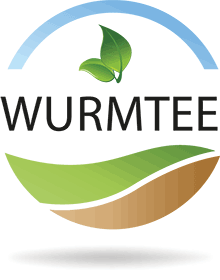Forschungsergebnisse über Regenwürmer:
Die Drilosphäre ist der Bereich im Boden beeinflusst durch Würmer, ihre Sekrete, Kanäle und Ausscheidungen:
- Darwin F, Seward AC (1903) More letters of Charles Darwin
- Martin JP (1976) Darwin on earthworms: the formation of vegetable moulds. Bookworm Publishing, Ontario
- Lavelle E, Barois I, Martin A, Zaidi Z, Schaefer R (1989) Management of earthworm populations in agro-ecosystems: A possible way to maintain soil quality? In: Clarholm M, Bergstrom
- L (eds) Ecology of Arable Land: Perspectives and Challenges, Kluwer Academic Publishers, London. pp 109-122
- Brown GG, Barois I, Lavelle P (2000) Regulation of soil organic matter dynamics and microbial activity in the drilosphere and the role of interactions with other edaphic functional domains. Eur J Soil Biol 36:177-198
Die Rolle der Regenwürmer im Celluloseabbau und in der Humusanreicherung und deren Einfluss auf die physikalischen, chemischen und biologischen Eigenschaften des Bodens:
- Edwards CA, Lofty R (1977) The Biology of Earthworms. Chapmann and Hall, London.
- Kale RD, Bano K (1986) Field Trials with vermicompost (vee comp. E. 8. UAS) on organic fertilizers. In: Dass MC, Senapati BK, Mishra PC (eds) Proceedings of the national seminar on organic waste utilization, Sri Artatrana Ront, Burla. pp 151-157
- Jambhekar H (1992) Use of earthworm as a potential source of decompose organic wastes. Proc Nat Sem Org Fmg, Coimbatore. pp 52-53
Mikroorganismen, Enzyme und Hormone im Regenwurmdarm und ihre Rolle in der schnellen Zersetzung von halbverdautem Material im Wurmkompost:
- Ghosh M, Chattopadhyay GN, Baral K (1999) Transformation of phosphorus during vermicomposting. Bioresour Technol 69:149-154
- Nagavallemma KP, Wani SP, Stephane L, Padmaja VV, Vineela C, Babu Rao M, Sahrawat KL (2004) Vermicomposting: Recycling wastes into valuable organic fertilizer. Global Theme on Agrecosystems Report no.8. Patancheru 502324. International Crops Research Institute for the Semi-Arid Tropics, Andhra Pradesh. p 20
- Bernal MP, Faredes C, Sanchez-Monedero MA, Cegarra J (1998) Maturity and stability parameters of composts prepared with a, wide range of organic wastes. Bioresour Technol 63:91-99
- Sánchez-Monedero MA, Roig A, Paredes C, Bernal MP (2001) Nitrogen transformation during organic waste composting by the Rutgers system and its effects on ph, EC and maturity of the composting mixtures. Bioresour Technol 78:301-308
- Sánchez-Monedero MA, Roig A, Paredes C, Bernal MP (2001) Nitrogen transformation during organic waste composting by the Rutgers system and its effects on ph, EC and maturity of the composting mixtures. Bioresour Technol 78:301-308
- Dominguez J, Edwards CA (2004) Vermicomposting organic wastes: A review. In: Shakir Hanna SH, Mikhail WZA (eds) Soil Zoology for sustainable Development in the 21st century, Cairo. pp 369-395
Aktivierung der ruhenden Mikroben und Keime von Endosporen und Verdauungsenzymen, wie Amylase, Cellulase, Protease, Lipase, Chitinase und Urease im Verdauungstrakt der Regenwürmer:
- Munnoli PM, Da Silva JAT, Saroj B (2010) Dynamics of the soil-earthworm-plant relationship: a review. Dynamic soil, dynamic plant. 1-21
Beseitigung von für Pflanzen schädlichen Pilzen und Mikroben durch die Verdauung der Regenwürmer:
- Lazcano C, Gomez-Brandon M, Dominguez J (2008) Comparison of the effectiveness of composting and vermicomposting for the biological stabilization of cattle manure. Chemosphere 72:1013-1019
Einteilung der Regenwürmer in epigäische, anektische und endogäischen Arten und ihre Rolle in der Wurmkompostierung, Bodenfruchtbarkeit und im Ökosystem:
- Brown GG (1995) How do earthworms affect microfloral and faunal community diversity? Plant Soil 170:209-231
- Bhatnagar RK, Palta RK (1996) Earthworm-Vermiculture and Vermicomposting. Kalyani Publishers, New Delhi.
- Kooch Y, Jalilvand H (2008) Earthworm as ecosystem engineers and the most important detritivors in forst soils. Pak J Boil Sci 11:819-825
- Asha A, Tripathi AK, Soni P (2008) Vermicomposting: A Better Option for Organic Solid Waste Management. J Hum Ecol 24:59-64
- Kale RD, Bano K (1988) Earthworm cultivation and culturing techniques for the production of vee COMP83E UAS. Mysore J Agric Sci 2:339-344
- Sinha RK, Heart S, Agarwal S, Asadi R, Carretero E (2002) Vermiculture technology for environmental management: study of the action of the earthworms Eisenia foetida, Eudrilus euginae and Perionyx excavatus on biodegradation of some community wastes in India and Australia. The Environmentalist 22:261-268
- Munnoli PM, Da Silva JAT, Saroj B (2010) Dynamics of the soil-earthworm-plant relationship: a review. Dynamic soil, dynamic plant. 1-21
- Suthar S, Singh S (2008) Vermicomposting of domestic waste by using two epigeic earthworms (Perionyx excavatus and Perionyx sansibaricus). Int J Evniron Sci and Technol 5:99-106
- Ismail SA (1997) Vermicology: The biology of Earthworms. Orient Longman Limited, Chennai
- Nakamura Y (1996) Interactions between earthworms and microorganisms in biological control of plant root pathogens. Farming Jpn 30:37-43
- Brown GG, Barois I, Lavelle P (2000) Regulation of soil organic matter dynamics and microbial activity in the drilosphere and the role of interactions with other edaphic functional domains. Eur J Soil Biol 36:177-198
- Munnoli PM, Da Silva JAT, Saroj B (2010) Dynamics of the soil-earthworm-plant relationship: a review. Dynamic soil, dynamic plant. 1-21


